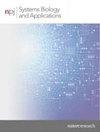网络拓扑和交互逻辑决定了它所支持的状态。
IF 3.5
2区 生物学
Q1 MATHEMATICAL & COMPUTATIONAL BIOLOGY
引用次数: 0
摘要
在这篇综述论文中,我们总结了描述网络支持的动态范围问题的最新进展。我们表明,由多值单调布尔函数集合组成的网络模型与常微分方程模型之间存在天然联系。我们展示了如何构建这样的集合,并用它们来回答与网络模型均衡点相对应的细胞表型的流行率问题。本文章由计算机程序翻译,如有差异,请以英文原文为准。

Network topology and interaction logic determine states it supports.
In this review paper we summarize a recent progress on the problem of describing range of dynamics supported by a network. We show that there is natural connection between network models consisting of collections of multivalued monotone boolean functions and ordinary differential equations models. We show how to construct such collections and use them to answer questions about prevalence of cellular phenotypes that correspond to equilibria of network models.
求助全文
通过发布文献求助,成功后即可免费获取论文全文。
去求助
来源期刊

NPJ Systems Biology and Applications
Mathematics-Applied Mathematics
CiteScore
5.80
自引率
0.00%
发文量
46
审稿时长
8 weeks
期刊介绍:
npj Systems Biology and Applications is an online Open Access journal dedicated to publishing the premier research that takes a systems-oriented approach. The journal aims to provide a forum for the presentation of articles that help define this nascent field, as well as those that apply the advances to wider fields. We encourage studies that integrate, or aid the integration of, data, analyses and insight from molecules to organisms and broader systems. Important areas of interest include not only fundamental biological systems and drug discovery, but also applications to health, medical practice and implementation, big data, biotechnology, food science, human behaviour, broader biological systems and industrial applications of systems biology.
We encourage all approaches, including network biology, application of control theory to biological systems, computational modelling and analysis, comprehensive and/or high-content measurements, theoretical, analytical and computational studies of system-level properties of biological systems and computational/software/data platforms enabling such studies.
 求助内容:
求助内容: 应助结果提醒方式:
应助结果提醒方式:


